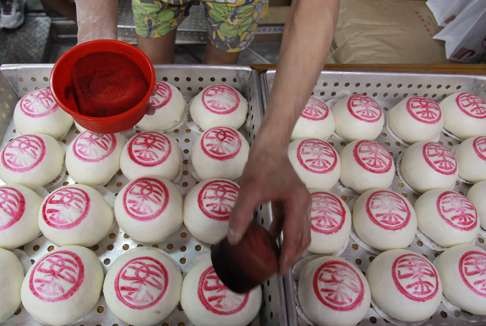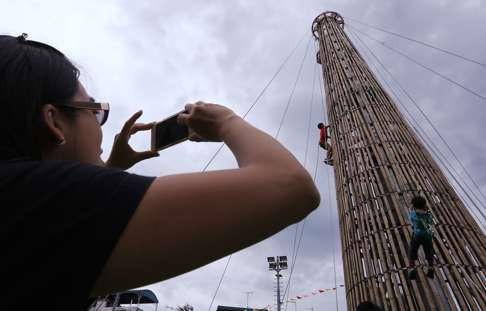
The blessed buns that helped scare off a plague on Cheung Chau
Delving into the history of Hong Kong’s Cheung Chau bun festival, which concludes on Saturday with the bun scrambling competition

For more than 22,000 residents of Cheung Chau, the fourth month of the lunar calendar sees the annual celebration of the popular carnival, the Cheung Chau Bun Festival.
According to folklore, the carnival began in the late 19th century when a plague besieged the island and took numerous lives.
Locals hired priests to placate the wandering spirits of dead islanders in front of Temple of Pak Tai, the Taoist God of the Sea, while parading the deity’s statue along Cheung Chau’s narrow streets.
The plague ceased subsequently, and Pak Tai rose to be a spiritual hero that has been worshipped annually on the island ever since.
The week-long festival, which usually takes place in May, attracts tens of thousands of visitors every year.

And many of its traditions still remain in its 21st-century version: hiring Taoist priests to invite deities, serving vegetarian food at restaurants, and setting up bamboo towers stacked with blessed buns for worshipping – which give the event its name.
The buns, symbolising peace and luck, are made from water, flour and sugar and come in three traditional flavours – sweetened bean, lotus seed and sesame. They are inscribed with the Chinese characters Ping An for ‘peace’.
The week-long festival, which is solely funded by its organising committee, costs about HK$1 million in total to stage, according to Yung Chi-ming, who has served as chairman of the festival’s organising committee since 2004. The event was placed on China’s national list of intangible cultural heritage in 2011.
“It takes around one to two months for preparation,” Yung said.
The festival, which began on May 11, culminates today with the Pik Siu “Floating Colours” parade from 2pm to 4pm, followed by the Bun Scrambling Competition.
The Piu Sik Parade sees young children, aged between five and eight, dressed in colourful costumes to resemble deities or modern celebrities, carried shoulder-high on metal structures or floats to appease wandering ghosts.
Watch: How Cheung Chau prepares for its annual Piu Sik parade
The parade also serves as an outlet for political satire and protests. In 2014, a girl impersonated Chief Secretary Carrie Lam Cheng Yuet-ngor holding a hammer with the Basic Law under her feet – a mockery of Lam’s assertion that mainland officials had given the last word on electoral reform in Hong Kong.
The parade is then followed by the Bun Scrambling Competition, which begins at 11.30pm.
Four bun towers are installed in front of Pak Tai Temple. Among them, three towers – about 13 metres high – carry about 20,000 real buns. The other, slightly taller tower, studded with about 9,000 plastic buns that look like real ones from the outside, is prepared for the bun scramblers.

The competition sees 12 contestants, at least three of whom are women, scrambling as fast as possible to the top of the tower while collecting buns on the way within a set time frame.
The higher the buns are placed, the more points they carry. Hence the scramble for the buns at the top of the tower.
The remaining real buns are distributed to crowds at the scene once the event ends.
Sporty bun pluckers used to step on real buns before 1978, when two bun towers collapsed and injured 24 people, most of whom were scramblers.
At the time of the collapse, about 200 people were scrambling up three bun towers to bag as many as possible. On the remaining tower, some frenzied climbers “still clawed their way to the top and punched through from inside the frame, oblivious,” a Post reporter wrote at the time.
The government banned the event but it resumed in 2005, after organisers agreed to replace bamboo cones with steel A-frames in scaffolding bun towers and control the number of scramblers.
In 2007, the festival’s organisers decided to use plastic buns for scrambling and snatching, citing aesthetic and environmental concerns. It received some criticism from the community for deviating from its cultural heritage.
The latest record holder is fireman Jason Kwok Ka-ming, the island resident who has won the event six times.
Besides logistics, weather is another big concern. Last year, the competition was cancelled due to heavy rain. The government has taken precautions this year: If bad weather occurs again, it may be called off but prizes will still be handed out based on 12 finalists’ results in their selection stage.
How Pak Tai rid the world of evil ... and lost his beard
Pak Tai, or “Northern Emperor” in Chinese, is the main deity worshipped for the bun festival.
According to a popular legend of Taoism, a Chinese philosophy and religion, Pak Tai – a prince at birth in the Shang dynasty more than 3,000 years ago – became an erudite Taoist in his youth and later an immortal.
During the final years of the Shang dynasty, so the legend goes, demons swept the world, and the highest deity of Taoism called in Pak Tai to fight the demons, which brought in a giant tortoise and serpent for the battle. Pak Tai won and earned himself the title of “Supreme Emperor of Dark Heaven”.
In Chinese philosophy, north stands for water, therefore many people also regard Pak Tai as a sea deity. Many early settlers in Cheung Chau were fishermen from southern China. Living a life at sea, they worshipped gods who could protect them from sea disasters. Goddess Tin Hau is one. Pak Tai is another.
A typical Pak Tai statue portrays him with long hair and chest-length beard, sitting barefoot and stepping on a serpent and a tortoise, which symbolise the defeated evil. But visitors won’t find his beard on his statue in Cheung Chau’s Pak Tai temple. According to folklore, years ago a fire broke out on a bamboo stage of a Chinese opera performance. During the chaotic escape, an old man extinguished the fire with buckets of water. The next day, when islanders went to worship at the temple, Pak Tai’s beard was gone, which they took as a sign that Pak Tai had incarnated as the old man and sacrificed his beard to save people’s lives.